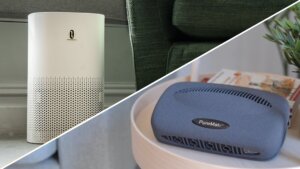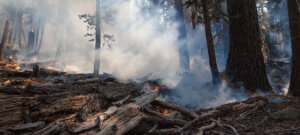At some point in everyone’s life, your home will smell stale or musty like an old locker room. You might also have concerns about pollutants in the air or odors from mysterious sources.
An air purifier with a HEPA filter is still the best way to clear pollutants from your home. However, if you don’t have an air purifier and need to banish the stink fast, there are some ways you can instantly freshen up the air. Most of these involve ways to increase airflow and reduce pollutants, but we’ll also look at common clean air “hacks” you have to avoid.
7 ways to keep home air clean without an air purifier
You might think you need an air purifier to keep your home environment clean. While it’s still the best tool in your arsenal to combat pollutants, here are a few tips you can employ for a breath of (literal) fresh air.
1. Open windows and use fans
To reduce indoor air pollutants, the EPA recommends opening windows and doors and running window or attic fans to increase the amount of outdoor air coming in.
If you have a window AC with open vent control, perfect. Use that. The World Health Organization states that natural ventilation is more economical and better for the environment. You save money and the Earth!
Natural ventilation is opening windows and doors, or installing solar chimneys, wind towers, and trickle ventilators to let air in naturally. Mechanical ventilation involves installing fans in windows or walls, or putting them into air ducts. Note that air purifiers complement ventilation — they’re not a type of ventilation themselves.
Be mindful of anyone in the home with allergies or asthma, as opening windows could invite allergens or asthma triggers like pollen. Use a different method to clean the air in this case, ideally an air purifier.
2. Reduce infection risk with HVAC systems and exhaust fans
The CDC recommends turning on exhaust fans in the bathroom or kitchen and keeping your HVAC system fans on when guests are over. This reduces the risk of infection from things like the flu or COVID-19.
According to the CDC, using pleated filters in your HVAC system can also mean more efficient air ventilation. Make sure you install the filter properly and change it every three months or according to manufacturer instructions.
3. Control outdoor sources of pollution by weatherizing
Open windows are effective and all, but in today’s polluted world, there are times when it’s actually better to keep them shut. For example, if there’s wildfire smoke outside, you’ll need to seal up. This is what the EPA calls “weatherizing.
Weatherization is the process of making your home ready for the winter. Most of it focuses on reducing the strain on your HVAC system by reducing the energy transfer between the indoors and outdoors.
Weatherizing also works to keep your air clean, though. Put adhesive barrier tape around window and door frames for an extra seal against outdoor air pollutants. You might also want to use door draft stoppers.
4. Clean your home regularly, avoid biological contaminants
Biological contaminants like mold, bacteria, dust mites, pollen, and pet dander thrive in dirty homes.
- The EPA recommends drying out and cleaning up any water damage immediately to avoid mold growth.
- Vacuum and dust regularly.
- Use allergen-proof mattress encasements for those with allergies.
- Wash bedding in hot water, which is known for killing dust mites and other allergens.
5. Use fewer burning products
The EPA states that burning products are a large contributor to indoor pollutants like carbon monoxide, nitrogen dioxide, and smoke particles. Try to avoid or cut down on using candles, incense, wood stoves, fireplaces, or gas stoves. Use exhaust fans in the kitchen when cooking. Also, if you’re still smoking indoors and reading about how to keep air clean… take it outside.
Make sure to measure radon and carbon monoxide in the home using home-based readers, as recommended by the EPA.
A tabletop air quality sensor such as the Qingping Air Quality Monitor Pro can help you keep an eye on the levels of VOCs, particulate matter (PM2.5, PM10), CO2, and humidity at home.
6. Don’t use dangerous cleaning chemicals
Many cleaning products exude fumes that aren’t safe to breathe in, according to the Agency for Toxic Substances and Disease Registry. The agency recommends several ways to clean the home safely:
- Open a window or use a fan to ventilate the area while cleaning.
- Store cleaning products in a safe place with the original container tightly sealed.
- Never mix cleaning products and follow instructions.
- Try using natural cleaners like white vinegar and baking soda.
7. Be especially careful with new carpets
The EPA reports that some people are sensitive to new carpets. A number of issues could cause this, like the chemicals used during manufacturing, pollutants picked up on the way, or any number of things.
- Choose carpets carefully, reviewing possible emissions and low-emitting adhesives.
- Ventilate the area during and right after installation.
- Leave the area during installation if possible.
- Unroll the carpet in a well-ventilated area.
- Talk to the carpet retailer if there are persistent odors from the new carpet.
Online advice that’s a waste of time
Cleaning “hacks” are usually sensationalized for views and don’t actually clean your home environment properly. Not all hacks, but these ones in particular are pretty popular:
1. Using plants as a purifier. Plants are great at sprucing up your home, but plants do not clean air.
2. Masking scents with candles. People use candles for pretty fragrances, but they can actually emit chemicals that are more harmful than helpful.
3. Spraying scented air fresheners. Air fresheners are go-to for masking scents quickly, but the University of Massachusetts Amherst states that they can release VOCs. Air fresheners can cause headaches and nausea, and irritate the eyes, nose, and throat. If you want a better-smelling home, try these green air freshener ideas instead.
4. Putting scented items in creative places. There’s a curious hack going around that states you can freshen up your home by putting dryer sheets in your air vents. Michigan State University states that certain chemicals in dryer sheets can cause allergic reactions, asthma, migraines, and trigger dermatitis in some people. Oh, and they’re also a fire hazard, according to ACE Home Services.
While these tips don’t work, getting an air purifier probably will.
Should you get an air purifier?
Even with all these tips, you should still consider an air purifier, especially one with a HEPA filter. They’re designed to filter pollutants right out of the air and help take care of dust, pollen, mold, bacteria, and other small particulates. Follow this flow chart to see if you need an air purifier and which kind:

Wrapping up
If you don’t have an air purifier, there are a number of ways you can still get clean air yourself. They mostly involve ventilating your home, but also using natural cleaning products, weatherizing the home, using fewer burning products, measuring harmful pollutants, and maintaining a regular cleaning schedule.
If you’re short on cash, you can also put together do-it-yourself devices, like a CR Box or a DIY air purifier. These allow you to make your own air purifier with filters, duct tape, and a box fan. In this video, Danny explains how:
@thishousefresh A cheap air purifying hack that works as well as a $500 Dyson air purifier. With just a box fan, screwdriver, scissors, duct tape and any HVAC filter you can make your own air purifier than can remove dust, pollen, mold spores and bacteria. #airpurifier #cleanair #lifehack #easydiy #homediyideas #cleantok #diyprojects ♬ original sound – HouseFresh
SOURCES
- ACE Home Services. Should I Put Dryer Sheets in My AC Intake Vent at Home? acehomeaz.com
- Agency for Toxic Substances and Disease Registry. How to Reduce Your Exposure to Chemicals at Home, Work and Play. atsdr.cdc.gov
- Centers for Disease Control and Prevention. (2023). Improving Ventilation in Your Home. cdc.gov
- The Guardian. (2023). Too many smelly candles? Here’s how scents impact the air quality in your home. theguardian.com
- Michigan State University. (2022). Dryer Sheet Ingredient Safety. canr.msu.edu
- U.S. Environmental Protection Agency. (2023). The Inside Story: A Guide to Indoor Air Quality. epa.gov
- U.S. Environmental Protection Agency. (2023). What is a HEPA Filter? epa.gov
- University of Massachusetts Amherst. Air Fresheners and Indoor Air Quality. ehs.umass.edu
- World Health Organization. (2009). Natural Ventilation for Infection Control in Health-Care Settings. ncbi.nlm.nih.gov






